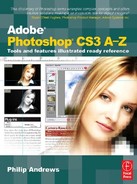]>
The Type tool’s Underline option draws a straight line below the group of letters it is applied to (1). The thickness and color of the line are determined by the current font size and color.
To add an underline to existing text, start by selecting the letters (click-drag the type cursor over the letter group) and then press the Underline button in the Character palette (Window > Character).
To create underline text from the very first letter you input, select the Type tool and then press the Underline option in the Character palette (2). Next click onto the canvas surface and add the text as normal.
The Underpainting fi lter, as one of the group of Artistic fi lters, adds both texture and brush stroke effects to the photo.
The dialog contains several controls that adjust the painting and texture effects. The top slider, Brush Size (1), alters the broadness of the brush stroke used to paint the picture. The Texture Coverage slider (2) controls how much of the picture the texture is applied to.
Texture options are provided in the bottom section of the dialog (3). The Texture and Light drop-down menus found here, along with the Scaling and Relief sliders, determine the type and strength of the underlying texture effect.
The Undo command reverses the changes made by the last action. In effect, by selecting the Undo command you are converting the picture back to the state it was before the last action.
Located under the Edit menu, the actual Undo entry changes depending on the nature of the last action. In the example, the command reads ‘Undo Hue/Saturation’ as the last change to the picture was made using the Hue/Saturation feature. Selecting Undo reverses the changes (2) and restores the picture to its state before the feature was applied (1).
To ungroup all layers in a group (set) select the group heading in the Layers palette and then choose Layer > Ungroup Layers.
Photoshop contains four lock options located at the top of the Layers palette. These buttons enable the locking of layer transparency, pixels, position or all of these characteristics.
To apply a lock select a layer and click the appropriate lock button (1). To remove or unlock the layer press the button again (2).
Of the various sharpen filters that Photoshop contains the Unsharp Mask and the Smart Sharpen filters provide the greatest control over the sharpening process by giving the user a range of sliders which when adjusted alter the way the effect is applied to pictures. Though a little confusing to start with, the Unsharp Mask filter is one of the best ways to make your scans or digital photographs clearer. However, to get the most out of the feature you must carefully control the three sliders.
The Amount slider (1) controls the strength of the sharpening effect. Larger numbers will produce more pronounced results whereas smaller values will create more subtle effects. Values of 50% to 100% are suitable for low resolution pictures whereas settings between 150% and 200% can be used on images with a higher resolution.
The Radius slider (2) value determines the number of pixels around the edge that are affected by the sharpening. A low value only sharpens edge pixels. High settings can produce noticeable halo effects around your picture so start with a low value first. Typically, values between 1 and 2 are used for high resolution images, and settings of 1 or less for screen images.
The Threshold slider (3) is used to determine how different the pixels must be before they are considered an edge and therefore sharpened. A value of 0 will sharpen all the pixels in an image whereas a setting of 10 will only apply the effect to those areas that are different by at least 10 levels or more from their surrounding pixels. To ensure that no sharpening occurs in sky or skin tone areas set this value to 8 or more.
The Warp Text option creates twisted, stretched and distorted versions of text layers in Photoshop. The effect is applied by pressing the Warp Text button on the Type tool’s options bar and then adjusting the settings in the Warp Text dialog. Once applied the layer thumbnail changes to indicate that the text has been warped (1). To unwarp the text, double-click the text layer, to switch to the Type tool and then press the Warp Text button on the tool’s options bar. Next, choose the None entry (2) from the Style menu in the Warp Text dialog. This action removes the warp effect from the text layer.
The Adobe Update Manager is an automatic utility that installs with Photoshop and is responsible for maintaining the currency of the program. The feature checks for the availability of new updates for Adobe software via an active web link at the time of starting the program.
The default settings for the feature can be altered in the Adobe Updater Preferences dialog (1), which is displayed when Photoshop first opens or by selecting Help
> Updates (2).
Uniform Resource Locator, or URL, is the formal term that refers to the web address (1) of a specific website.
Clicking on the colored Feathers icon (2) at the top of the toolbar is a shortcut to locating the official Photoshop website or URL. Pressing this button takes you directly to the site.
The Use All Layers option (1) found in options bar of the Clone Stamp, Smudge, Blur, Sharpen, Paint Bucket and Healing Brush tools. It allows the user to select a sample area based on all visible layers not just the contents of the selected layer.
In CS2 the Use All Layers option was replaced with the Sample All Layers feature (2). This setting still resides on the options bar of the tools with which it can be used.
In CS3 the Healing Brush and Clone Stamp tools have extra sampling options in a drop-down menu (3) on the tool’s options bar.







































